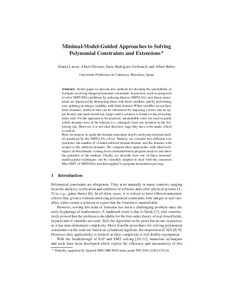Mostra el registre d'ítem simple
Minimal-model-guided approaches to solving polynomial constraints and extensions
| dc.contributor.author | Larraz Hurtado, Daniel |
| dc.contributor.author | Oliveras Llunell, Albert |
| dc.contributor.author | Rodríguez Carbonell, Enric |
| dc.contributor.author | Rubio Gimeno, Alberto |
| dc.contributor.other | Universitat Politècnica de Catalunya. Departament de Ciències de la Computació |
| dc.date.accessioned | 2014-10-10T06:16:02Z |
| dc.date.available | 2014-10-10T06:16:02Z |
| dc.date.created | 2014 |
| dc.date.issued | 2014 |
| dc.identifier.citation | Larraz, D. [et al.]. Minimal-model-guided approaches to solving polynomial constraints and extensions. A: International Conference on Theory and Applications of Satisfiability Testing. "Theory and Applications of Satisfiability Testing, SAT 2014 : 17th International Conference, held as part of the Vienna Summer of Logic, VSL 2014, Vienna, Austria, July 14-17, 2014 : Proceedings". Vienna: Springer, 2014, p. 333-350. |
| dc.identifier.uri | http://hdl.handle.net/2117/24333 |
| dc.description.abstract | In this paper we present new methods for deciding the satisfiability of formulas involving integer polynomial constraints. In previous work we proposed to solve SMT(NIA) problems by reducing them to SMT(LIA): non-linear monomials are linearized by abstracting them with fresh variables and by performing case splitting on integer variables with finite domain. When variables do not have finite domains, artificial ones can be introduced by imposing a lower and an upper bound, and made iteratively larger until a solution is found (or the procedure times out). For the approach to be practical, unsatisfiable cores are used to guide which domains have to be relaxed (i.e., enlarged) from one iteration to the following one. However, it is not clear then how large they have to be made, which is critical. Here we propose to guide the domain relaxation step by analyzing minimal models produced by the SMT(LIA) solver. Namely, we consider two different cost functions: the number of violated artificial domain bounds, and the distance with respect to the artificial domains. We compare these approaches with other techniques on benchmarks coming from constraint-based program analysis and show the potential of the method. Finally, we describe how one of these minimal-model-guided techniques can be smoothly adapted to deal with the extension Max-SMT of SMT(NIA) and then applied to program termination proving. |
| dc.format.extent | 18 p. |
| dc.language.iso | eng |
| dc.publisher | Springer |
| dc.subject | Àrees temàtiques de la UPC::Informàtica::Programació |
| dc.subject.lcsh | Max-SMT |
| dc.subject.lcsh | Logic programming |
| dc.subject.other | Formal logic |
| dc.title | Minimal-model-guided approaches to solving polynomial constraints and extensions |
| dc.type | Conference report |
| dc.subject.lemac | Programació lògica amb restriccions |
| dc.contributor.group | Universitat Politècnica de Catalunya. LOGPROG - Lògica i Programació |
| dc.identifier.doi | 10.1007/978-3-319-09284-3-25 |
| dc.description.peerreviewed | Peer Reviewed |
| dc.relation.publisherversion | http://link.springer.com/chapter/10.1007%2F978-3-319-09284-3_25 |
| dc.rights.access | Open Access |
| local.identifier.drac | 15228587 |
| dc.description.version | Postprint (author’s final draft) |
| local.citation.author | Larraz, D.; Oliveras, A.; Rodriguez, E.; Rubio, A. |
| local.citation.contributor | International Conference on Theory and Applications of Satisfiability Testing |
| local.citation.pubplace | Vienna |
| local.citation.publicationName | Theory and Applications of Satisfiability Testing, SAT 2014 : 17th International Conference, held as part of the Vienna Summer of Logic, VSL 2014, Vienna, Austria, July 14-17, 2014 : Proceedings |
| local.citation.startingPage | 333 |
| local.citation.endingPage | 350 |


